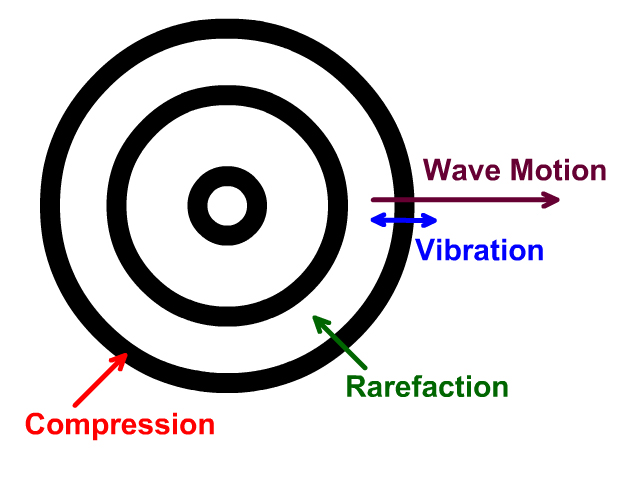Sound Waves
Sound waves are longitudinal mechanical waves that travel through medium. Our ears are special organs that sense the frequency that we hear as pitch.
Support Your Knowledge of Sound Waves With This Activity: Build a Straw Pan Flute
Variables Used on this Page
| Name | Variable | Unit | Unit Abbreviation |
| Velocity (sound) | v or vsound | meters per second | m/s |
| displacement or distance | x | meters | m |
| wavelength | 𝜆 | Meters | m |
| time | t | seconds | s |
| frequency | f | Hertz | Hz |
| Temperature Celsius | T°c | Celsius | °C |
Sound Waves are Longitudinal Mechanical Waves
Sound waves are produced from energy in a vibrating object. A speaker or someone's vocal cords when talking vibrate. Sound is a mechanical wave since it needs a medium like air to propagate or move. Sound will not move through a vacuum like space. Sound is a longitudinal wave with medium particles vibrating back and forth parallel to the direction the wave is traveling.
Sound Propagates in all Directions from the Source
A sound wave will propagate in all directions and has the four wave phenomena all waves have. Here a speaker in the center vibrates and the air particles around it vibrate as sound propagates outward.
An Echo is the Reflection of Sound
Sound has the four phenomena of all waves.
Reflection of sound is called an echo. An echo bounced off an object and returns to the source. A source is where the wave was created.
To hear an echo of your voice, the distance traveled is double that of from the source to the reflecting object.
Sound in air will travel the same velocity throughout since it is in the same medium. Use the constant velocity equation with your knowledge of an echo to solve the next problems.
v = x / t
Example Problems
1. How long would it take a person to hear his echo off a mountain 500 meters away when sound is traveling 340 m/s?
2. An echo off a wall takes 5 second to be heard when traveling 343 m/s. What is the distance to the wall?
Sound Frequency and Pitch
The frequency of a sound wave is perceived as what we call pitch. The higher the frequency the higher the pitch we hear. Humans can hear a frequency between 20 - 20,000 Hz which is called audible sound. Below 20 Hz in a range we cannot hear called infrasonic. Above 20,000 Hz is a range we cannot hear called ultrasonic. Some animals other than humans can hear outside of our audible range.
- 20 – 20,000 Hz is audible to an average person
- Less than 20 Hz is infrasonic
- Greater than 20,000 Hz is ultrasonic
You can hear the pitch of different frequencies and test what you can here by following this link to AudioNotch.
Loudness and Amplitude of Sound
Loudness of sound is determined by amplitude. The greater amplitude of a sound wave the louder the sound. Even though sound is a longitudinal wave, it's compression and rarefaction density can be graphed to observe the amplitude.
Speed of a Sound Wave
Sound is a mechanical wave. Mechanical waves need medium to travel and travel fastest in the most elastic (dense) medium. Sound would travel fastest in solid and slowest in gas. Sound does not travel in a vacuum. Sound cannot travel in space since it is a vacuum without medium.
Velocity of Sound in Air
Sound travels faster in warmer medium of the same chemical state (solid, liquid, or gas). The density of the medium is the most important factor in determining the speed of sound. After density, to determine speed in a medium temperature becomes a factor.
The velocity of sound in air can be determined by the equation below.
Vsound = 331 + (0.6) (T°c)
Vsound : velocity of sound in air
T°c : Temperature in Celsius
Example Problems
3. Does sound travel faster in -5°C Ice or 23° Celsius water?
4. What is the speed of a sound wave at 10°C?
5. How long would it take someone at the top of the Eiffel Tower to hear someone yelling from the ground 300 meters away on a day the temperature was 15°C?
6. How far is lightning if it takes 3 seconds to hear the thunder sound that follows a day temperature is 28°?
7. A train that transports iron ore is 2400 meters. How long would it take someone at the end of the train to hear the whistle from the front on a day the temperature was 32°?
8. How hot in Celsius is the temperature on a day sound travels at 354 m/s?
9. How far is a mountain when it takes 5 seconds to hear an echo off it on a day the temperature is 25°C?
10. How long does it take to hear an ambulance from a distance of 280 m if the speed of sound is 340 m/s?
11. How far does an echo travel that takes 1.5 seconds to get to a wall it reflects off of on a day the speed of sound is 343 m/s?
Links
- On to the Doppler Effect
- Back to the Main Waves Page
- Back to the Stickman Physics Home Page
- Equation Sheet






